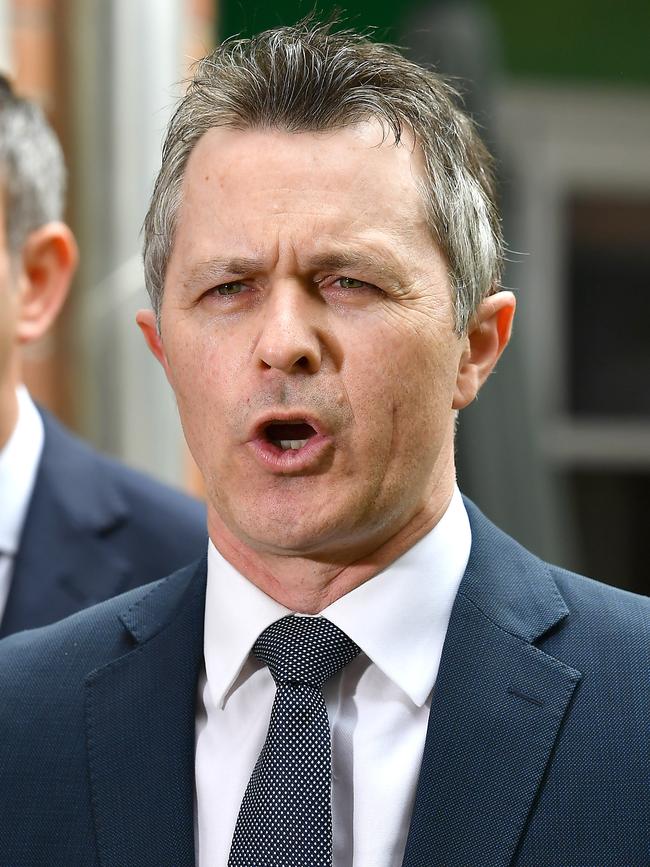$25m for ‘burnt-out’ teachers to work less
Taxpayers will spend $25m to help teachers work less in a ploy to plug the brain drain.

Taxpayers will spend $25m to help teachers work less, in a national ploy to plug the brain drain as burnt-out educators quit the classroom.
Warning that poor teenagers have fallen five years behind their well-off classmates in reading, federal Education Minister Jason Clare will target spending to attract, train and retain more school teachers.
“The gap between children from poor families and children from wealthy families is getting bigger,’’ he will tell the Australian Primary Principals Association national conference in Sydney on Thursday.
Citing damning data from this year’s National Assessment Program – Literacy and Numeracy (NAPLAN) testing of a million students, Mr Clare will reveal a two-year gap in the reading skills of eight-year-olds from wealthy and poor families – double the difference when NAPLAN started in 2008.

“That gap grows with every year of school, and by the time they get to year 9 that gap is over five (years),’’ he will tell the conference.
“Helping these children doesn’t just change their lives … it ricochets through generations.
“It means their children live different lives. It changes whole communities. It gives us the skills we need and it makes our whole country stronger.’’
Mr Clare will predict that it will take years to plug the brain drain from the teaching profession, with shortages particularly “bad in the bush’’.
“The next few years are going to be tough,’’ he will tell the principals. “In the last 10 years there has been a 16 per cent drop in the number of young people enrolling in teaching.
“Only 50 per cent of students who study teaching complete their degree. A lot of really experienced mid-career teachers are leaving too.
“ One of the reasons is workload – they are burnt out.
“That all comes together to create a teacher shortage crisis.’’
Mr Clare will announce $25m in federal funding to “trial new ways to reduce the workload on teachers and maximise the time they have to teach’’.
The plan to cut red tape for teachers by pooling and sharing lesson plans, as well as delegating non-teaching tasks to data analysts or office staff, will be part of $328m in federal funding to train more teachers.
The government will fund a trial of Productivity Commission recommendations to lighten the “complex and time-consuming’’ workload of teaching.
The commission’s interim report on education has found that teachers spend just 40 per cent of their work hours on face-to-face teaching, with nearly 10 per cent of time spent on general administrative tasks such as processing forms, marking rolls or handing out Covid-19 tests.
Fifteen per cent of teachers’ time is spent planning lessons and 4 per cent on extra-curricular activities such as school plays, musicals, homework clubs or sport.
“Administrative staff could reduce the workload of teachers by doing non-core teaching tasks, such as processing excursion permission slips, to free up teachers to focus on core teaching functions,’’ the report states.
“Rather than more staff overall, what appears to be required may be better use of existing non-teaching staff, particularly teaching assistants.’’
The latest Monash University survey of working conditions among 5497 teachers found that paperwork and data collection are bugbears for most teachers.
Three-quarters of teachers surveyed this year described their workloads as unmanageable, citing “useless administration’’ and suggesting that administrative staff deal with paperwork and compliance checks.
The national teaching workforce plan – to be released to teachers and principals for feedback before sign-off by Mr Clare and state and territory education ministers next month – includes a $10m marketing and advertising campaign to raise the status of the teaching profession.
Another $10m will pay for short courses to train teachers in phonics-based reading instruction, classroom management and specialist subjects such as the STEM field of science, technology, engineering and maths.
The workforce funding will include money announced in last month’s federal budget – $159m for extra university places to train more teachers, $56m for scholarships worth up to $40,000 to lure the “best and brightest’’ into teaching degrees, and $68m to triple the number of career-change professionals, such as lawyers and engineers, to retrain as school teachers.
The national plan will mention “economic and professional” barriers to teaching but does not directly address teacher pay, which is set by state and territory governments and the Catholic and independent school sectors.





To join the conversation, please log in. Don't have an account? Register
Join the conversation, you are commenting as Logout